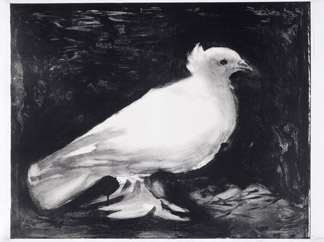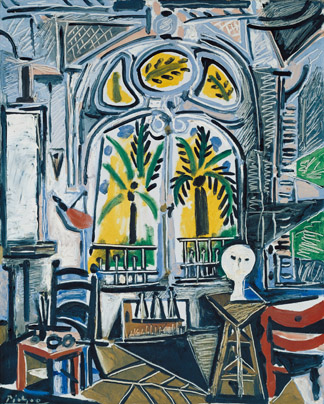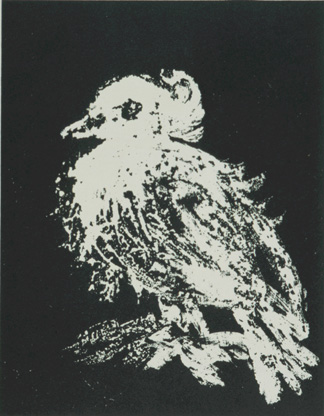Pablo Picasso: The Development of a Peace Symbol
By Ina Cole
ART TIMES May/ June 2010
 Pablo Picasso
Dove (La Colombe), 1949
Lithograph on paper
54.7 x 69.7 cm
Tate
© Succession Picasso/DACS 2009 Pablo Picasso
Dove (La Colombe), 1949
Lithograph on paper
54.7 x 69.7 cm
Tate
© Succession Picasso/DACS 2009 |
This year global interest in the work of Picasso is rekindled, due in part to the temporary closure and refurbishment of the Picasso Museum in Paris. This inimitable repository represents pieces that the artist retained with the intention of shaping his own artistic legacy, and its closure presents an opportunity for his works to travel to exhibitions around the world. As these exhibitions reveal, Picasso had an innate ability to evolve through time and history, creating formidable works that mirrored the political and social context in which they were created, yet simultaneously transcended the ideological and aesthetic oppositions of East and West.
During his long life Picasso witnessed both World Wars, the Spanish Civil War and Korean War, and each conflict exerted a powerful presence in the development of his work. In 1937 he painted the universally acclaimed Guernica, one of the most gut-wrenching depictions of the Spanish Civil War, which still retains its pre-eminence amongst the most hotly debated paintings of the twentieth-century. However, it is worth remembering that Picasso had been essentially apolitical before the Spanish Civil War; it was the German and Italian aerial attack on the Basque village of Guernica that contributed to his altered perspective on life, resulting in this apocalyptic interpretation of a widely condemned terror bombing.
Picasso spent most of the occupation in Paris, refusing offers for exile from the US and other countries. During the war the Nazi occupiers of Paris did not arrest Picasso - he was well known as the most important artist of the style Hitler had condemned as ‘degenerate art’. The Nazis attempted to beguile French intellectuals with food and coal - again, this was refused by Picasso, who characteristically reminded them that “a Spaniard is never cold”. Following the emancipation of Paris in 1944, Picasso - previously the leading practitioner of an art denounced by the fascists - became a hero of the liberation.
 Pablo Picasso
The Studio (L'Atelier), 1955 Pablo Picasso
The Studio (L'Atelier), 1955
Oil on canvas 80.9 x 64.9 cm Tate © Succession Picasso/DACS 2009 |
Motivated by idealistic and humanitarian concerns, Picasso joined the French Communist Party, believing Communism offered a path removed from the fascist atrocities of World War Two and the Spanish Civil War. His decision met with considerable controversy, generating an ongoing debate regarding his affiliation and the potential impact of this on his work. Certainly, after 1944 Picasso became a figurehead for left-wing causes, and it was during this period that the political content of his practise rose to the fore, with works that referenced crucial historical moments, chronicling human conflict and devastation, albeit exerting a strong desire for peace.
In January 1949 Picasso created Dove, an image that became an iconographic symbol of the period, frequently utilised in the propaganda war of the left and the Peace Movement, and one that became an emblem of hope during the Cold War. The dove in question was actually a Milanese pigeon - presented to Picasso as a gift from his contemporary Henri Matisse - and its resulting depiction became universally known as the ‘dove of peace’. The imagewas a lithograph, created in the studio of the printmaker Fernand Mourlot in Paris, and was published by the Galerie Louise Leiris in an edition of five artist’s proofs and fifty signed and numbered prints on white Arches wove paper. Picasso instinctively captured the essence of the dove’s form in pared down simplicity, creating a potent image of great physical vibrancy. The image portrays the exquisite white dove on a black background, rendered in lithographic ink wash. According to Mourlot, this work was one of the most technically astute and beautiful lithographs ever achieved through this medium.
Later that year the poet Louis Aragon, a staunch supporter of the French Communist Party, visited Picasso’s studio to choose a lithograph of the dove. The image was to become a universal phenomenon - it was selected for the poster of the First International Peace Congress in Paris in 1949, with Picasso later providing variations on the theme for the Peace Congresses in Wroclaw, Stockholm, Sheffield, Vienna, Rome and Moscow. The Peace Movement distributed images signed by Picasso, which were then multiplied throughout the world, creating an aura of notoriety around the artist and catapulting him to new heights of recognisability. However, the dove remained a personal as well as a political emblem for Picasso - an enduring childhood reminder of his father, a painter, who had drawn doves kept at the family home in Málaga in the 1880s.
 Small Dove, March 1949
(La petite colombe)
Lithograph 263 x 208mm
Sprengel Museum, Hannover
©Succession Picasso/DACS 2009 Small Dove, March 1949
(La petite colombe)
Lithograph 263 x 208mm
Sprengel Museum, Hannover
©Succession Picasso/DACS 2009 |
After World War Two, Picasso spent increasing periods of time in the South of France, closer to his native Spain. In 1955 he moved to La Californie, a commodious Art Nouveau villa overlooking Cannes, surrounded by palms and eucalyptus trees. It was here that Picasso built a dovecote, so he could closely observe the daily activities of his feathered companions. That year Picasso avidly depicted his new studio twelve times, sometimes with, sometimes without the resident doves. As a subject matter, the studio had been a particularly strong motivation for Matisse, and it has been suggested that this series was instigated by Picasso as a result of Matisse’s death the previous year.
Picasso died in April 1973 and was buried at the entrance to the Château de Vauvenargues at the foot of Mont Sainte Victoire. Although springtime, heavy snow began to fall uncannily, covering the landscape in a soft white blanket, as though an avalanche of white feathers had fallen from the sky. Picasso had, without question, led an exceptional, multi-faceted life, and his development of a peace symbol is only one facet of an unparalleled body of work. Picasso was fortunate in being able to work to the end, constantly re-inventing himself over nine decades through his clearly defined periods of creativity, well-documented personal life, numerous studio residences, and passionate views on life - all of which contributed to his unyielding position as the resilient forerunner of his generation.
2010 exhibitions:
Picasso, Pushkin Museum of Art, Moscow (to 23 May); Picasso in the Metropolitan Museum of Art, US (to 1 August); Picasso: Themes and Variations, MoMA, US (to 30 September); Pablo Picasso: In the Artist’s Studio, Graphik Museum Picasso, Münster, Germany (28 August – 21 November); Masterpieces from the Musée National Picasso, Paris, Seattle Art Museum, US (8 October – 9 January 2011); Picasso: Peace and Freedom, Tate Liverpool, UK (21 May – 30 August; touring to the Albertina, Vienna, 22 September – 16 January 2011); Picasso, Kunsthaus Zürich, Switzerland (15 October – 30 January 2011).
